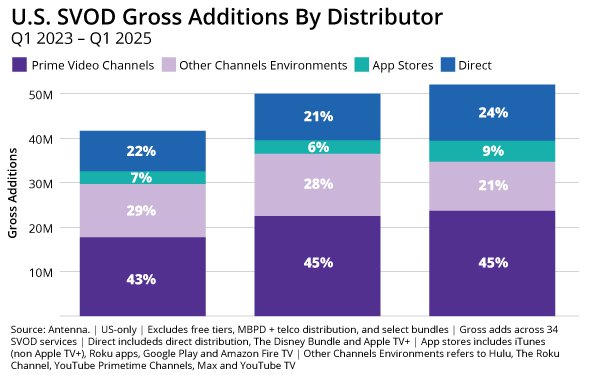Commentary
Streaming Q1: Third-Party Streaming Distributors Gaining Strength
- by Wayne Friedman , Staff Writer, July 9, 2025

A mature premium streaming video marketplace is currently getting major help from third-party distributors -- like Amazon Prime Video -- which account for one in three new streaming subscriptions, according to Antenna.
Gross subscriber additions rose to 52 million in the first quarter of 2025 -- up from 50 million the year before, according to the subscription research company. Those gross additions come from 34 streaming platforms.
Amazon’s Prime Video Channels rose to 24% share compared to 21% the year before -- with “other channels” distributors rising 9% from 6%. These channels' third-party distributors include Hulu, The Roku Channel, YouTube Primetime Channels, Max and YouTube TV.
Still, the biggest points of purchase are coming from direct purchases on the streaming platform itself -- roughly 45% (with 23 million gross subscriber additions).
advertisement
advertisement
At the same time, business from "app stores" has declined -- to around 10 million versus 12 million a year ago (21% share dropping from 28%). This includes subscriptions from iTunes, Google Play, Roku Apps, and Amazon Fire TV.
These results exclude legacy TV providers -- cable, satellite, telco and virtual providers.
“Different services are taking wildly different approaches to distribution,” the authors of the survey say.
On the one hand, Netflix is getting 100% of its new March 2025 subscriptions directly from its own platform (accounting for those provider exclusions).
On the other side, for example, Paramount+ gets 30% of its subscriptions from Amazon Prime Video and 39% from direct sales. The biggest third-party distribution for Peacock after its direct sales (55%) comes from iTunes (18%).
Overall, Amazon Prime Video Channels is seen as a significant player here. “Antenna estimates that a remarkable 89% of individuals (5.6 million) who signed up for one of these services through Prime Video would not have done so if the service was not available on the platform.”



